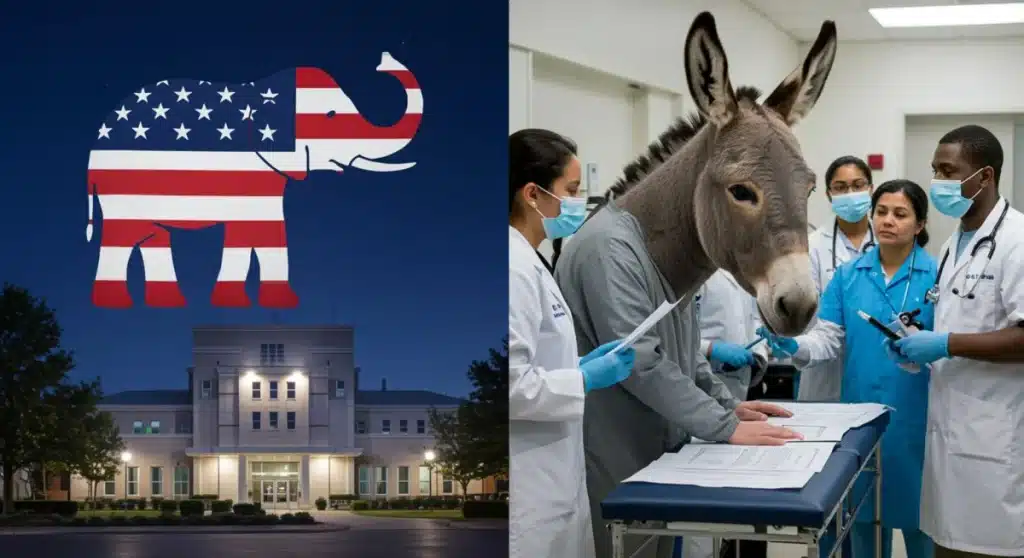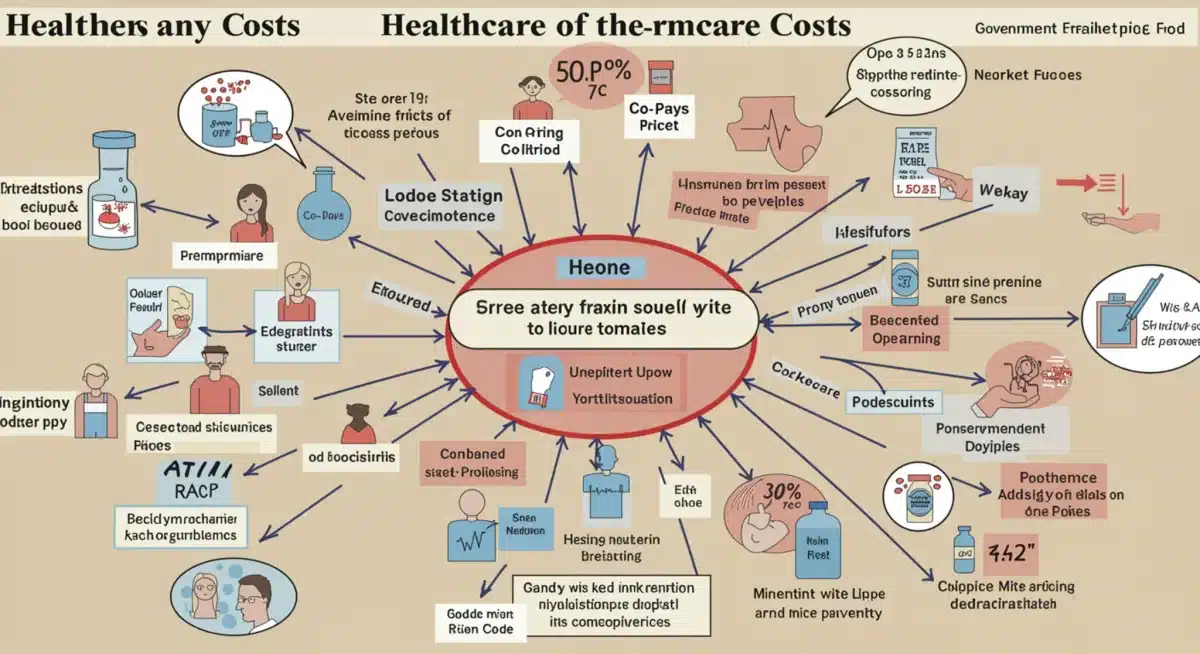Healthcare Reform 2025: Republican vs. Democratic Platforms

The Republican and Democratic platforms on healthcare reform in 2025 present fundamentally different visions, with Republicans generally advocating for market-based solutions and reduced government intervention, while Democrats champion universal access, affordability, and strengthening existing social safety nets like the ACA.
As the United States approaches 2025, the debate surrounding healthcare reform remains a central and highly contentious issue. Understanding what are the key differences between the Republican and Democratic platforms on healthcare reform in 2025 is not just an academic exercise; it’s essential for every American grappling with insurance premiums, access to care, and the future of their health. Both major parties offer distinct philosophies and policy proposals that promise to reshape the nation’s healthcare landscape, impacting millions of lives. This article will delve into these diverging paths, examining their core tenets, proposed solutions, and potential implications.
philosophical foundations of healthcare reform
At the heart of the Republican and Democratic approaches to healthcare reform lie deeply entrenched philosophical differences regarding the role of government, individual responsibility, and market forces. These foundational beliefs dictate the types of policies each party proposes and how they envision the ideal healthcare system functioning. Understanding these underlying philosophies is crucial for grasping the nuances of their respective platforms.
Republicans generally advocate for a system rooted in free-market principles, emphasizing individual choice, competition among providers, and reduced government intervention. They believe that market forces can drive down costs and improve quality, much like in other sectors of the economy. This perspective often leads to proposals that empower consumers to make their own healthcare decisions, supported by tax credits or health savings accounts, rather than government-mandated insurance schemes.
the republican stance: market-driven solutions
- Individual responsibility: Emphasizes personal accountability for health choices and insurance coverage.
- Market competition: Believes competition among insurers and providers will lower costs and improve quality.
- Limited government role: Advocates for reduced federal oversight and regulation in healthcare.
Democrats, conversely, tend to view healthcare as a fundamental right and a social good, rather than purely a market commodity. Their philosophy centers on the idea of universal access, ensuring that all citizens have affordable and comprehensive coverage, often through government programs or strong regulatory frameworks. They argue that market forces alone cannot adequately address issues of equity, access, and affordability, particularly for vulnerable populations.
the democratic stance: universal access and social equity
- Healthcare as a right: Prioritizes universal access to affordable healthcare for all citizens.
- Government regulation: Supports robust federal and state regulation to ensure fairness and protect consumers.
- Social safety net: Advocates for strengthening programs like Medicare, Medicaid, and the Affordable Care Act (ACA).
These contrasting philosophies set the stage for very different policy proposals. While Republicans seek to dismantle or significantly alter existing government programs like the ACA, Democrats aim to expand and fortify them. The debate is not merely about policy specifics but about fundamental disagreements on who should bear the primary responsibility for healthcare provision and access in American society.
insurance coverage and affordability: diverging paths
When it comes to how Americans obtain and afford health insurance, the Republican and Democratic platforms for 2025 present starkly different blueprints. These approaches dictate everything from the structure of insurance markets to consumer subsidies and protections, directly impacting millions of households across the nation.
Republicans largely favor a system that promotes private insurance, often through employer-sponsored plans or individual market options, with a focus on consumer-directed healthcare. They propose replacing the Affordable Care Act (ACA) with alternative mechanisms that emphasize tax credits, health savings accounts (HSAs), and interstate insurance sales. The goal is to give individuals more control over their healthcare dollars and choices, believing this will foster a more efficient and responsive market.
republican proposals for coverage
- Tax credits: Offering refundable tax credits to help individuals purchase private insurance, replacing ACA subsidies.
- Health savings accounts (HSAs): Expanding and enhancing HSAs, allowing individuals to save tax-free for medical expenses.
- Interstate insurance sales: Permitting insurers to sell policies across state lines to increase competition and choice.
Democrats, on the other hand, staunchly defend and seek to expand the Affordable Care Act. They champion policies aimed at increasing enrollment in ACA marketplaces, strengthening subsidies to make plans more affordable, and potentially introducing a public option. Their focus is on ensuring that everyone has access to comprehensive, affordable coverage, regardless of pre-existing conditions or income level. They believe that a more regulated market with a strong public component is necessary to achieve universal coverage and protect consumers from predatory practices.
democratic proposals for coverage
- Strengthening the ACA: Expanding subsidies and outreach to increase enrollment in ACA marketplace plans.
- Public option: Creating a government-run health insurance plan to compete with private insurers, offering more affordable options.
- Lowering eligibility age for Medicare: Potentially allowing individuals to buy into Medicare at an earlier age.
The implications of these differing approaches are profound. Republican proposals could lead to a highly individualized insurance market with potentially lower premiums for healthier individuals but possibly higher costs and less comprehensive coverage for those with greater healthcare needs. Democratic plans aim for broader coverage and stronger protections but could involve higher government spending and increased regulation. The choice between these paths represents a fundamental decision about the balance between individual liberty and collective responsibility in healthcare.
addressing healthcare costs: strategies and debates
Controlling the escalating costs of healthcare is a paramount concern for both Republicans and Democrats, yet their strategies for achieving this goal are fundamentally at odds. The rising expenses for premiums, deductibles, and prescription drugs continue to burden American families and businesses, making the approaches to cost containment a critical differentiator between the two parties in 2025.
Republicans typically argue that excessive regulation and a lack of market competition are primary drivers of high costs. Their proposed solutions often involve deregulation, promoting price transparency, and fostering greater competition among providers and pharmaceutical companies. They believe that empowering consumers with more information and choice will naturally lead to a more efficient and cost-effective system. This includes pushing for reforms that allow consumers to shop for services and drugs, much like they would for other goods.
republican approaches to cost containment
- Price transparency: Mandating hospitals and insurers to disclose prices for services to encourage comparison shopping.
- Tort reform: Limiting malpractice lawsuits to reduce defensive medicine and associated costs.
- Market-based drug pricing: Encouraging competition among pharmaceutical companies and potentially allowing importation of cheaper drugs from other countries, though often with less government negotiation.

Democrats, conversely, attribute high costs to a combination of factors, including corporate greed, insufficient regulation, and the inherent inefficiencies of a fragmented system. Their solutions often involve direct government intervention to negotiate drug prices, strengthen consumer protections against surprise billing, and expand the use of value-based care models. They argue that without strong regulatory oversight, healthcare providers and pharmaceutical companies will continue to prioritize profits over affordability and patient well-being.
democratic approaches to cost containment
- Prescription drug price negotiation: Empowering Medicare to negotiate drug prices directly with pharmaceutical companies, extending benefits to all Americans.
- Curbing surprise billing: Implementing and strengthening federal protections against unexpected medical bills from out-of-network providers.
- Investing in preventive care: Focusing on preventative health measures to reduce the incidence of chronic diseases and the need for expensive treatments.
The debate over cost containment highlights the ideological divide: Republicans seek to unleash market forces, while Democrats aim to harness government power to rein in expenses. Each approach carries its own set of potential benefits and risks, with implications for innovation, access, and the financial stability of the healthcare system. The effectiveness of either strategy in 2025 will depend heavily on implementation and market response.
the role of government in healthcare regulation
The extent and nature of government involvement in healthcare regulation represent another significant fault line between Republican and Democratic platforms for 2025. This area encompasses everything from oversight of insurance companies and medical providers to funding for public health initiatives and research. The differing views on regulation directly influence the structure and accessibility of the entire healthcare system.
Republicans generally advocate for less government intervention and deregulation in the healthcare sector. They believe that excessive federal regulations stifle innovation, increase administrative burdens, and ultimately drive up costs. Their platform often calls for devolving more power to states, allowing them to tailor healthcare solutions to their specific populations without federal mandates. This approach emphasizes market-driven solutions and consumer choice, with minimal federal oversight of insurance plans or provider networks.
republican stance on regulation
- State control: Shifting regulatory authority from the federal government to individual states.
- Reduced mandates: Eliminating or scaling back federal requirements for insurance coverage and benefits.
- Streamlined processes: Aiming to reduce bureaucratic hurdles for providers and insurers to foster efficiency.
Democrats, conversely, argue for robust federal regulation to protect consumers, ensure quality of care, and prevent market abuses. They believe that without strong governmental oversight, insurance companies might deny coverage for pre-existing conditions, pharmaceutical companies could set exorbitant prices, and hospitals might engage in unfair billing practices. Their platform supports federal standards for insurance plans, consumer protections, and significant investment in public health infrastructure and research.
democratic stance on regulation
- Consumer protection: Maintaining and strengthening federal protections for individuals, including those with pre-existing conditions.
- Federal oversight: Ensuring federal agencies have the authority to regulate insurance markets, drug prices, and healthcare quality.
- Public health investment: Increasing funding for public health programs, disease prevention, and medical research.
The debate over government regulation touches upon fundamental questions of individual liberty versus collective well-being. Republicans envision a system where individuals and states have maximum autonomy, while Democrats strive for a more standardized and federally protected system. The outcome of this debate in 2025 will determine the degree to which healthcare is viewed as a private commodity or a public utility, with profound implications for patient rights, access, and overall system stability.
medicaid, medicare, and social safety nets
The future of critical social safety net programs like Medicaid and Medicare is a major point of contention between Republican and Democratic platforms for 2025 healthcare reform. These programs provide essential coverage for millions of low-income individuals, the elderly, and people with disabilities, making their proposed reforms highly impactful and often emotionally charged.
Republicans generally seek to reform Medicaid by converting it into a block grant program for states. This approach would give states greater flexibility in how they design and administer their Medicaid programs, often with the aim of reducing federal spending and allowing states to implement more tailored, and potentially more restrictive, eligibility requirements and benefit packages. For Medicare, Republican proposals often include raising the eligibility age, introducing premium support models, or encouraging greater private plan enrollment, driven by concerns about the program’s long-term fiscal sustainability.
republican proposals for social safety nets
- Medicaid block grants: Providing states with a fixed amount of federal funding, giving them more control but potentially reducing overall funding.
- Medicare eligibility age: Considering an increase in the age of eligibility for Medicare to address solvency concerns.
- Premium support for Medicare: Shifting Medicare to a system where the government provides a fixed contribution, allowing seniors to choose from private plans.

Democrats, conversely, are staunch defenders of Medicaid and Medicare as essential pillars of the nation’s healthcare system. They advocate for strengthening and expanding these programs, resisting any efforts to cut benefits, reduce eligibility, or privatize services. For Medicaid, Democrats support maintaining or expanding federal funding and ensuring comprehensive coverage for eligible populations. For Medicare, proposals often include negotiating drug prices, expanding covered benefits, and potentially lowering the eligibility age to broaden access.
democratic proposals for social safety nets
- Strengthening Medicaid: Preserving federal funding and expanding eligibility to cover more low-income individuals.
- Protecting Medicare benefits: Opposing any cuts to Medicare benefits or increases in the eligibility age.
- Medicare drug price negotiation: Empowering Medicare to negotiate lower prescription drug prices for all beneficiaries.
The debate over these programs is not just about budgetary concerns but also about fundamental questions of social responsibility and the government’s role in providing a safety net. Republican reforms aim to reduce federal outlays and inject market principles, while Democratic proposals prioritize universal access and the preservation of benefits for vulnerable populations. The choices made in 2025 regarding these programs will have profound and lasting effects on millions of Americans’ health security.
patient choice and provider networks
The concepts of patient choice and the structure of provider networks are critical areas where Republican and Democratic platforms for healthcare reform in 2025 diverge significantly. These aspects directly influence how individuals select their doctors, access specialized care, and navigate the healthcare system, impacting both autonomy and convenience.
Republicans typically emphasize maximizing patient choice through a variety of private insurance options and broader provider networks. They advocate for policies that allow individuals to choose their own doctors and hospitals without undue restrictions from insurance plans. This often involves promoting health plans with wider network access, potentially through deregulation that allows for more flexible plan designs. The belief is that competition among providers for patients will drive better service and quality.
republican emphasis on patient choice
- Broad networks: Encouraging insurance plans to offer extensive networks of doctors and hospitals.
- Direct contracting: Allowing individuals and employers to contract directly with providers for services.
- Portability of insurance: Making it easier for individuals to carry their insurance plans across state lines or between jobs.
Democrats, while also valuing patient choice, tend to prioritize comprehensive coverage and affordability, which sometimes necessitates more managed care networks. They focus on ensuring that patients have access to a full spectrum of services within their chosen plan, even if that means a more defined network of providers. Their proposals often include strengthening consumer protections to prevent surprise out-of-network billing and ensuring that networks are adequate to meet the needs of all enrollees, especially in rural or underserved areas.
democratic emphasis on patient access and network adequacy
- Network adequacy standards: Implementing and enforcing regulations to ensure insurance networks are sufficient to meet patient needs.
- Protection against surprise billing: Strengthening legislation to shield patients from unexpected charges from out-of-network providers.
- Support for underserved areas: Investing in programs to attract and retain healthcare professionals in rural and low-income communities.
The tension between these approaches lies in balancing choice with affordability and comprehensive coverage. Republican policies aim to empower individual consumers with more options, potentially leading to varied levels of coverage and cost. Democratic policies seek to ensure a baseline of comprehensive and affordable care for all, which might involve more structured networks and stronger regulatory oversight. The outcome of these debates in 2025 will shape how patients interact with the healthcare system and the choices available to them.
preventive care and public health initiatives
The importance of preventive care and robust public health initiatives is widely acknowledged, yet the Republican and Democratic platforms for 2025 healthcare reform propose different levels of investment and approaches to these critical areas. These differences reflect broader ideological stances on government spending, individual responsibility, and the role of collective action in promoting societal well-being.
Republicans generally support preventive care as a means to reduce long-term healthcare costs, but their proposals often focus on individual responsibility and market-based incentives rather than broad government programs. They might advocate for tax benefits for wellness programs, employer-sponsored initiatives, and health savings accounts that can be used for preventive services. While recognizing the value of public health, their emphasis tends to be on targeted interventions and local control, rather than extensive federal mandates or funding for large-scale public health campaigns.
republican approach to prevention and public health
- Individual wellness incentives: Promoting tax credits or other incentives for individuals who participate in wellness programs.
- Employer-led initiatives: Encouraging businesses to offer robust preventive care and wellness programs to employees.
- Localized public health: Supporting state and local public health departments with less federal oversight.
Democrats place a strong emphasis on comprehensive preventive care and robust public health infrastructure as cornerstones of a healthy society. They advocate for significant federal investment in public health programs, disease prevention, and health promotion initiatives. Their platform often includes expanding access to preventive services with no co-pays, funding for research into chronic diseases, and strengthening the nation’s capacity to respond to public health crises. They see public health as a collective responsibility that requires strong governmental leadership and sustained funding.
democratic approach to prevention and public health
- Expanded preventive services: Ensuring all insurance plans cover a wide range of preventive services with no out-of-pocket costs.
- Federal public health funding: Increasing federal investment in agencies like the CDC and state public health departments.
- Addressing social determinants of health: Implementing policies that tackle underlying factors like poverty, education, and environmental conditions that impact health outcomes.
The divergent approaches mean that under a Republican administration, preventive care might be more reliant on individual choice and market incentives, potentially leading to disparities in access. Under a Democratic administration, there would likely be a more centralized, federally funded approach to public health and preventive services, aiming for broader and more equitable access. The decisions made in 2025 will significantly influence the nation’s ability to prevent disease, promote wellness, and respond effectively to future health challenges.
| Key Aspect | Republican Platform (2025) | Democratic Platform (2025) |
|---|---|---|
| Core Philosophy | Market-based, individual choice, limited government. | Universal access, healthcare as a right, government regulation. |
| Insurance Coverage | Replace ACA, tax credits, HSAs, interstate sales. | Strengthen ACA, expand subsidies, public option. |
| Cost Control | Price transparency, tort reform, market competition. | Drug price negotiation, anti-surprise billing, preventive care. |
| Social Safety Nets | Medicaid block grants, higher Medicare age. | Expand Medicaid, protect Medicare benefits, drug negotiation. |
frequently asked questions about healthcare reform
Republicans generally advocate for market-driven solutions, emphasizing individual choice and reduced government intervention. Democrats, conversely, view healthcare as a fundamental right, pushing for universal access, affordability, and robust government regulation to ensure equitable coverage for all citizens.
Republicans typically propose cost containment through price transparency, tort reform to limit malpractice lawsuits, and fostering greater market competition among providers and pharmaceutical companies. They believe deregulation and consumer empowerment will naturally drive down expenses.
Democrats aim to strengthen insurance coverage by expanding and enhancing the Affordable Care Act (ACA), increasing subsidies to make plans more affordable, and potentially introducing a public health insurance option. They also seek to lower the Medicare eligibility age.
Republicans often propose converting Medicaid into block grants for states and reforming Medicare by potentially raising the eligibility age. Democrats staunchly defend and seek to expand both programs, resisting cuts and advocating for drug price negotiation within Medicare.
Republicans generally advocate for less government regulation, shifting power to states and reducing federal mandates. Democrats support robust federal regulation to protect consumers, ensure quality of care, and prevent market abuses, viewing it as essential for an equitable system.
conclusion
The distinct approaches of Republican and Democratic platforms on healthcare reform in 2025 underscore a fundamental ideological divide that shapes the future of American healthcare. From the philosophical underpinnings of government’s role to granular policy proposals on insurance coverage, cost containment, social safety nets, and preventive care, each party offers a vastly different vision. Republicans lean towards market-driven solutions, emphasizing individual choice and deregulation, believing that competition will foster efficiency and affordability. Democrats, conversely, prioritize universal access, affordability, and robust government intervention, viewing healthcare as a fundamental right that requires strong regulatory frameworks and a comprehensive social safety net. As the nation moves closer to 2025, understanding these critical differences will empower citizens to make informed decisions that will profoundly impact the accessibility, quality, and cost of healthcare for generations to come. The debate will continue to be a defining feature of American politics, reflecting deeply held beliefs about individual liberty versus collective responsibility in one of society’s most vital sectors.





